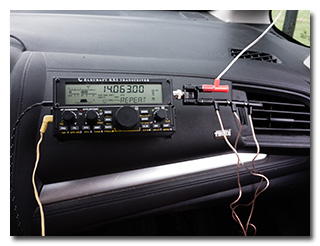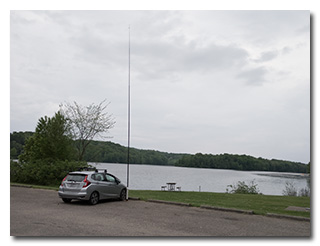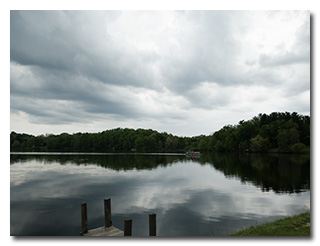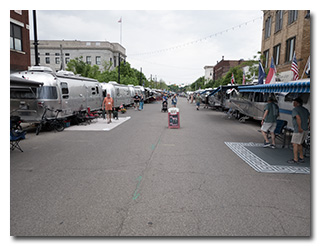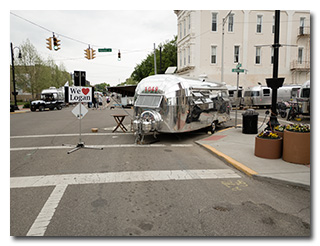
by William Eric McFadden
From the park's website:
-
Lake Logan is located in Hocking County in southeastern Ohio. This territory once belonged to the Wyandot Native Americans, who had a large village known as Oldtown on the Hocking River, located one mile north of Logan. Logan was established by Thomas Worthington in 1816 and named after the Mingo Chief, James John Logan.
The Hocking River provided sufficient water power for the operation of grist and sawmills, particularly at the falls above Logan. The town of Logan was slow to progress until the opening of the Hocking Canal, a branch of the Ohio-Erie Canal, in 1838. Several industries prospered due to the rich mineral resources of the Hocking Valley. The discovery of immense quantities of coal gave rise to a flourishing mining industry. Towns appeared and vanished as quickly as mines opened and closed.
It was soon found that iron ore could be extracted from the sandstone bedrock of the area. During the Civil War, Ohio’s iron industry reached its peak as the leading producer of iron for implements and weapons. No less than 46 furnaces were firing in Ohio’s six-county Hanging Rock Iron Region.
The clay soils of the Hocking Valley helped Ohio become a leader in clay products. The valley’s firebrick industry manufactured clay tile, building and paving bricks, and clay sewer pipe. Evidence of the industry can be seen in the many brick houses and abandoned kilns of the area. Clay is still an important commodity in the region.
Lake Logan was developed in 1955 for recreational purposes. The area was administered by the ODNR Division of Wildlife until 1964, when jurisdiction was transferred to the Division of Parks and Recreation. Originally known as Hocking Lake, the park was renamed Lake Logan to reflect the Native American heritage of the area and to avoid confusion with nearby Hocking Hills State Park and Forest.
Pictures
- Eric's KX2 station inside the car
- Eric's mast and antenna
- Lake Logan
- "Wake Up Downtown" Logan: 1 | 2
Description
On Friday, May 3, 2024, one member of the Southeast Ohio Radio Adventure Team performed a successful activation of Lake Logan State Park in Ohio as part of the Parks on the Air (POTA; link) program.
While enroute home from a veterinary visit at MedVet Diley Hill for Theo-dog, and at the urging of his wife, Eric McFadden, WD8RIF, stopped at the fishing peninsula on the eastern shore of Lake Logan to perform a quick activation before proceeding into downtown Logan to see 101 Airstream campers gathered for a "Wake Up Downtown" event. Eric was joined by his wife Vickie and little dogs Theo and Ginny. (A bit of backstory: On the previous Monday, 13lb Theo was very badly mauled by the neighbor's 50lb pit bull and suffered a long and deep cut on his throat and a deep but smaller laceration to his cheek. MedVet Diley Hill, a 24/7 emergency veterinary clinic located in Canal Winchester, found Theo to have no internal injuries, cleaned smaller lacerations, and stitched up the major lacerations, leaving a drain out of the neck wound. The trip back to MedVet Diley Hill on the afternoon of the 3rd was to have the drain removed.)
Despite having beautiful weather all morning and for the early afternoon drive to the veterinarian, rain arrived just as Eric, Vickie, and the dogs were nearing Lake Hope State Park. They arrived at the state park's fishing peninsula, finding the parking lot to nearly empty. The rain wasn't heavy, but Eric preferred to not subject his KX2 or paper logsheets to any precipitation and, not knowing of any covered picnic shelters anywhere within the state park, he decided to set up his station inside the car. Eric has done many, many activations in his car with his KX3 mounted on the dashboard, but this was to be the first time he had mounted his KX2 to the car's dashboard for an activation.
After Eric walked Theo, and while Vickie was walking Ginny, Eric deployed his 28½' wire vertical on his 31' Jackite telescoping fiberglass mast held upright on a drive-on base, mounted his KX2 on the car's dashboard, and was on the air at 2025 UTC. Eric doesn't (yet) carry a transformer for the 28½' wire antenna in the KX2 Mini Travel Kit and this would turn out to bite Eric, pun intended; more on this, below.
As at his previous activations of this park, Eric had good cell-signal and he would be able to spot himself on POTA Spots (link) and to use POTA Spots to identify possible park-to-park (P2P) QSO opportunities.
Knowing that solar conditions were not good, and expecting the higher bands to be more productive than the lower bands, Eric began his operation on 20m. Finding himself a frequency to run, he began calling "CQ POTA", and was reassured to be auto-spotted on POTA Spots. After three minutes of calling, Eric's first and only QSO on 20m came at 2028 UTC with N5IM in Texas.
After several more minutes of calling "CQ" on 20m with no responses, Eric decided to hunt for P2P QSOs, but found that band conditions on 20m were so poor he was unable to hear any of the other activators running on that band. However, at 2038 UTC, Eric managed to make a P2P QSO on 40m with K2HVN who was activating Ashmere Lake State Forest (US-4723) in Massachusetts.
Hoping that 40m might be in better shape, Eric found himself a clear frequency to run, began calling "CQ POTA", and self-spotted himself on POTA Spots. His first QSO in this run came at 2042 UTC with his friend Mike, K8RAT, in Ohio. QSOs came steadily, with Eric's fifteenth QSO in this run coming at 2059 UTC with K2EAG in Pennsylvania. This run included a P2P QSO with KE8PTX at Port Huron State Game Land (US-6762) in Michigan, a P2P QSO with KN3A at Prince Gallitzin State Park (US-1403) in Pennsylvania (3), and QSOs with operators located in Ohio (3), Michigan (4), Maryland, North Carolina (2), Wisconsin, Indiana, and Georgia.
Eric finished his activation by again hunting for P2P QSO opportunities and at 2102 UTC he completed a P2P QSO on 30m with W8NWG at Lincoln's New Salem State Historic Site (US-8306) in Illinois.
In all, Eric made eighteen QSOs, with four P2P QSOs. All of Eric's QSOs were CW and were made with five watts output.
During his run on 20m, Eric received a painful RF burn through a metal bit on his mostly-plastic Whiterook MK-33 paddle. This is not the first time he has felt RF while operating his KX2 into the 28½' wire antenna; in fact, every time he has operated his KX2 into the 28½' wire using a binding-post adapter instead of an unun, he has felt RF on the key. Eric has decided he needs to either build or buy a 4:1 unun to carry in the KX2 Mini Travel Kit for use with the 28½' wire, or to cut himself a 28½' wire to use with his Tufteln EFRW 9:1 balun. (The Tufteln EFRW antenna, with a 35' radiator and three 17' counterpoise wires, is the primary antenna in the KX2 Mini Travel Kit, but it's too long to deploy as a vertical on the 31' Jackite mast. The 28½' wire serves as a backup antenna, but it's the perfect length to hang as a true vertical on the 31' Jackite mast.)
UPDATE 2024-05-06: Eric discovered that the binding-post adapter he has been carrying in his KX2 Mini Travel Kit had the red and black binding-posts swapped: the red side of the adapter was connected to the KX2's chassis and the black side of the adapter was connected to the KX2 antenna connector's center pin, meaning that he had been connecting the three 17' counterpoise wires to the center pin and the 28½' wire to the KX2's chassis. Could this arrangement have been the reason Eric felt RF on his key every time he used the binding-post adapter? Very probably. The red and black parts easily threaded all the way off ofthe two binding posts, and Eric was able to swap them so that now red connects to the center pin and black connects to chassis-ground. Eric will test to determine if this, in fact, reduces or eliminates the RF on the key.
Following the successful activation, Eric, Vickie, and the dogs drove the short distance to downtown Logan to see the "Wake Up Downtown" (link) gathering of 101 Airstream campers.
Eric also submitted his log to the World Wide Flora and Fauna in Amateur Radio (WWFF; link) program.
(return)
